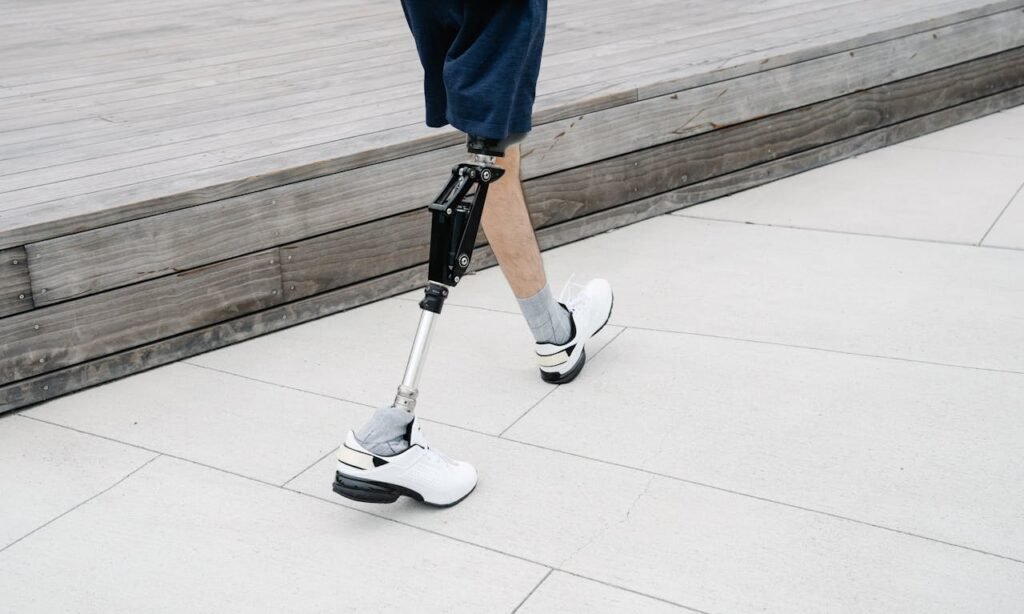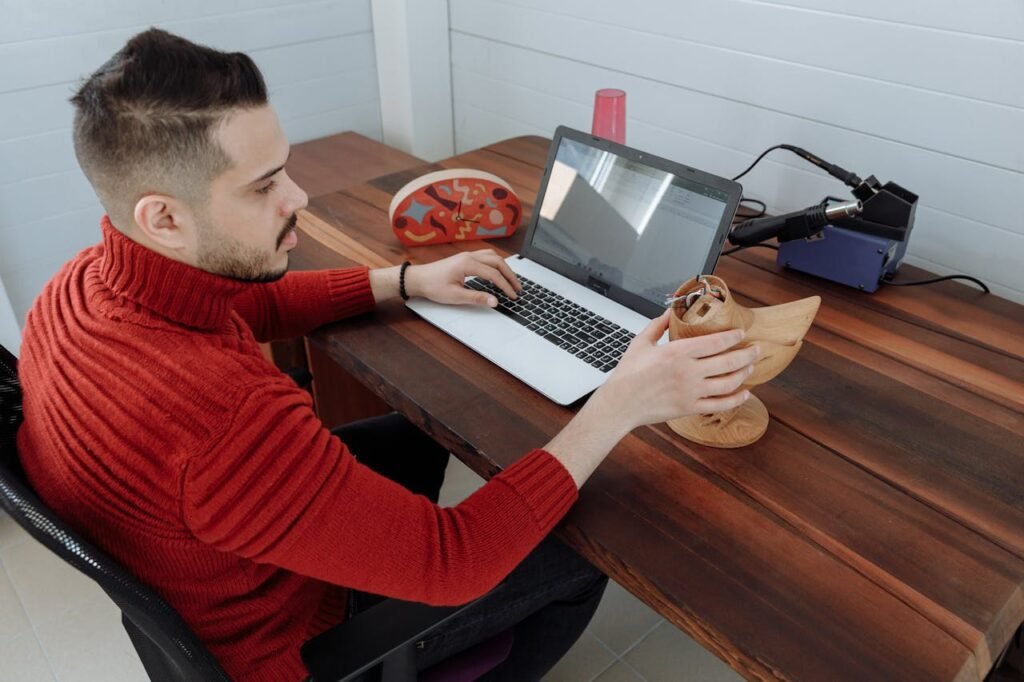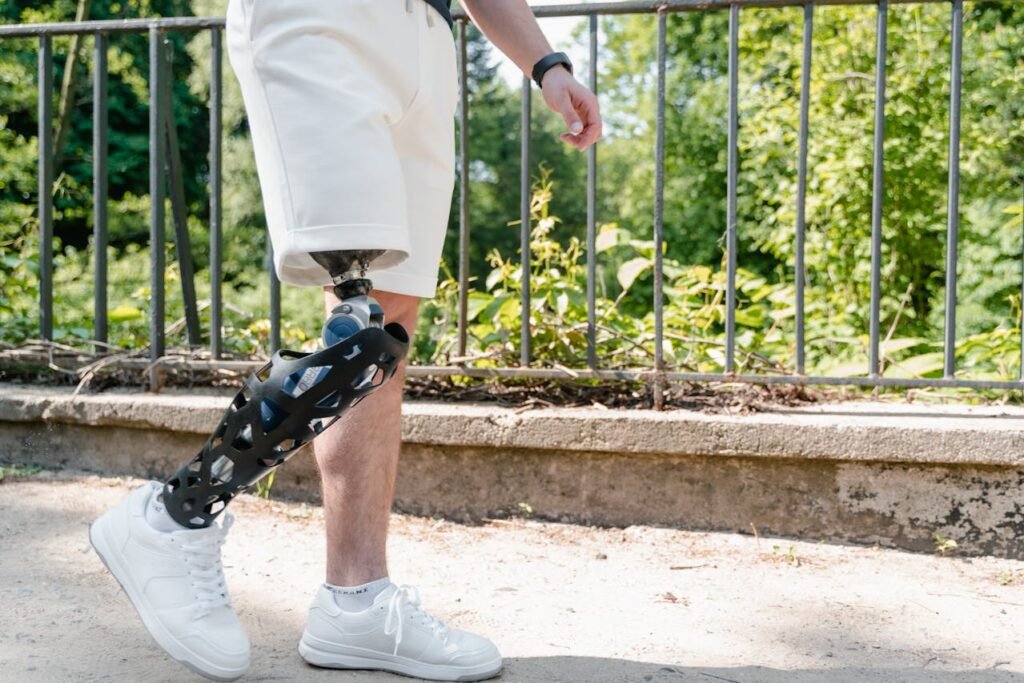Running is a powerful expression of freedom, strength, and determination. For individuals with limb loss, it can also be a deeply personal journey of resilience and rediscovery. Prosthetics designed for runners are transforming what’s possible for athletes, offering specialized solutions that enhance speed, stability, and endurance. Whether you’re a seasoned competitor or just beginning your running journey, choosing the right prosthetic can unlock new levels of performance and confidence.
Understanding Running Prosthetics
Running prosthetics are unlike standard devices designed for everyday use. These specialized prosthetics prioritize performance, using innovative materials and designs to maximize energy efficiency, shock absorption, and ground contact. Their purpose isn’t just to replicate walking—it’s to help runners achieve a natural stride while optimizing power and agility.
The Science Behind Running Prosthetics
Running places unique demands on the body, and running prosthetics are engineered to meet these challenges head-on. At the heart of their design is the concept of energy return, where the prosthetic stores kinetic energy during compression and releases it during the push-off phase.
This mechanism mimics the spring-like action of tendons and muscles, propelling the runner forward with minimal energy loss.
For businesses, emphasizing this functionality in product descriptions and demonstrations can resonate with users seeking high-performance solutions. Highlighting how advanced materials, such as carbon fiber, enhance energy return while keeping the prosthetic lightweight reinforces the value of these devices.
Key Components of a Running Prosthetic
A running prosthetic typically consists of several specialized components, each designed to optimize performance:
- Blade or foot design: The most recognizable feature of a running prosthetic is its curved blade, shaped to mimic the function of a foot and ankle during running. These blades are often made from carbon fiber to ensure both strength and flexibility.
- Socket and alignment: The socket, which connects the prosthetic to the residual limb, plays a critical role in comfort and stability. A precise fit and proper alignment are essential for preventing discomfort and maximizing performance.
- Pylon or connector: This component links the blade to the socket and is often adjustable to fine-tune the prosthetic’s height and angle.
For businesses, offering personalized fittings and adjustment services ensures that users achieve the optimal setup for their unique anatomy and running style. Educating users about the importance of proper alignment helps them understand how it impacts both comfort and performance.
The Dynamics of Running
Running is fundamentally different from walking, requiring prosthetics that can handle higher impact forces and the cyclical nature of acceleration and deceleration.
While walking involves a relatively consistent gait with periods of dual support, running eliminates double support entirely, relying on a series of airborne phases.
This means the prosthetic must absorb shock upon landing, store energy efficiently, and release it during the push-off phase—all while maintaining balance and stability.
For businesses, this insight into the biomechanics of running offers an opportunity to create prosthetics that align closely with the demands of the sport.
Collaborating with biomechanical experts to refine these elements ensures that products not only perform well but also feel intuitive to users. Educating customers about how these dynamics influence prosthetic design can deepen their understanding and appreciation for the technology.

Tailoring Prosthetics to Performance Goals
Running prosthetics are not one-size-fits-all; they are tailored to meet specific performance goals and user preferences. Factors such as the type of running—whether sprinting, long-distance, or trail running—play a significant role in determining the appropriate prosthetic design.
Additionally, individual attributes like stride length, residual limb characteristics, and physical fitness levels must be considered.
Businesses should invest in personalized consultations to assess each runner’s unique needs. Using advanced tools like gait analysis or motion capture systems can provide valuable data to guide the fitting and customization process.
By positioning themselves as partners in the athlete’s journey, companies can build trust and establish a reputation for delivering tailored solutions that elevate performance.
The Role of Energy Return
One of the defining features of running prosthetics is their ability to provide energy return—a mechanism that mimics the natural spring-like behavior of tendons during running.
High-performance materials like carbon fiber are commonly used in running blades, allowing them to store kinetic energy during compression and release it during push-off. This energy return not only enhances speed but also reduces the physical effort required, helping runners maintain endurance over longer distances.
For businesses, emphasizing the science behind energy return in marketing materials can appeal to performance-driven athletes. Demonstrations or side-by-side comparisons of different prosthetic models can showcase how variations in blade design or material composition influence energy efficiency.
Providing clear explanations of these technical features ensures that customers feel informed and confident in their decision.
Balancing Comfort with Functionality
While performance is a top priority for running prosthetics, comfort remains a critical consideration. An ill-fitting or poorly aligned prosthetic can cause pain, chafing, or imbalances that hinder performance and increase the risk of injury.
The socket, which connects the prosthetic to the residual limb, plays a central role in achieving a secure and comfortable fit.
Businesses should prioritize precision in socket design, offering adjustable or custom-molded options that accommodate changes in limb shape over time.

Providing clear guidance on how to achieve proper alignment and recommending regular check-ups to assess fit ensures that users can perform at their best without discomfort.
Highlighting the importance of this balance between comfort and functionality in consultations and educational materials helps build credibility and user trust.
Exploring the Best Models for Runners
The market for running prosthetics is diverse, catering to a wide range of needs, skill levels, and athletic goals. From entry-level devices designed for recreational runners to high-performance models used by elite athletes, there’s a solution for everyone.
Entry-Level Running Prosthetics
For beginners or those transitioning from walking prosthetics to running, entry-level models provide a balanced introduction to the world of running.
These devices are designed with a focus on stability and ease of use, allowing new runners to build confidence and adapt to the unique motion of running.
Businesses should position entry-level prosthetics as accessible options for those starting their journey. Providing testimonials from first-time runners or hosting workshops to help users acclimate to these devices can foster trust and engagement.
High-Performance Prosthetics
For competitive runners, high-performance prosthetics are engineered to deliver maximum speed, agility, and responsiveness. These models often feature advanced blade designs with optimized energy return and enhanced ground grip.
Some devices even incorporate adjustability features that allow athletes to fine-tune their performance for different terrains or events.
For businesses, showcasing the achievements of athletes who use high-performance models can inspire prospective buyers. Highlighting features like durability, precision engineering, and customizability reinforces the value of investing in top-tier prosthetics.

Specialty Running Prosthetics
In addition to general-purpose models, some running prosthetics are tailored for specific sports or activities. For example, sprinting prosthetics prioritize explosive power and acceleration, while models designed for long-distance running focus on shock absorption and endurance.
Businesses can enhance their offerings by developing prosthetics for niche activities, such as trail running or obstacle courses. Collaborating with professional athletes or sports organizations to test and refine these designs ensures they meet the demands of specialized use cases.
Emerging Technologies in Running Prosthetics
The field of running prosthetics is constantly evolving, driven by advancements that push the boundaries of what athletes can achieve. From cutting-edge materials to smart technologies, these innovations are transforming the performance, comfort, and accessibility of running prosthetics. For businesses, staying ahead of these trends is critical for delivering solutions that meet the needs of modern athletes.
Smart Prosthetics with Adaptive Features
Smart technology is revolutionizing prosthetics by enabling devices to adapt to the user’s movements and environment in real time. In running prosthetics, sensors and microprocessors are being integrated to provide instant adjustments for factors like terrain, stride length, or pace.
These systems analyze data and dynamically alter resistance or alignment to optimize performance and prevent fatigue.
For businesses, incorporating smart features into running prosthetics represents a significant opportunity to lead in innovation. Educating users about how these technologies enhance their running experience—such as smoother transitions between surfaces or improved energy efficiency—can drive interest and adoption.
Advanced Materials for Enhanced Performance
Material science is playing a pivotal role in the next generation of running prosthetics. Carbon fiber remains the gold standard for energy return and durability, but researchers are exploring even lighter and stronger composites that can further reduce weight and increase responsiveness.
Additionally, new materials that mimic human tissues are being developed to improve comfort and reduce the risk of skin irritation.
Businesses that integrate these advanced materials into their designs can offer users significant performance and comfort advantages. Promoting these innovations as part of a commitment to quality and cutting-edge design helps establish credibility and attract discerning athletes.
Customization Through 3D Printing
3D printing is making prosthetics more accessible and personalized than ever before. This technology allows manufacturers to produce custom-fit sockets and components quickly and cost-effectively, ensuring that every prosthetic is tailored to the user’s unique anatomy.
For runners, this means a more secure and comfortable fit that enhances performance.
Businesses leveraging 3D printing should emphasize the speed, precision, and personalization this technology enables. Offering consultations that include digital scans and visual previews of the prosthetic design creates a more engaging and reassuring customer experience.

AI-Driven Training and Rehabilitation
Artificial intelligence is not only enhancing the functionality of prosthetics but also transforming how athletes train and adapt to their devices. AI-powered platforms can analyze an athlete’s gait and provide recommendations for improving efficiency or avoiding injury.
These insights help runners optimize their performance and build confidence in their prosthetic.
For businesses, integrating AI-driven training tools into their offerings adds significant value for users. Highlighting these tools as part of a comprehensive support package sets the company apart as a forward-thinking partner in the athlete’s journey.
Actionable Advice for Businesses
The growing demand for running prosthetics presents a tremendous opportunity for businesses to innovate and expand their market presence. By focusing on user needs, leveraging emerging technologies, and delivering exceptional support, companies can establish themselves as leaders in this dynamic space.
Invest in User-Centric Design
Understanding the unique challenges and goals of runners is critical for creating prosthetics that truly meet their needs. Businesses should actively engage with athletes during the design and testing phases, gathering insights that inform every aspect of the prosthetic’s development.
From optimizing blade curvature for energy efficiency to ensuring a secure socket fit, user feedback should guide the process.
For example, collaborating with competitive athletes to test prototypes in real-world conditions can reveal opportunities for refinement. Sharing these partnerships and success stories in marketing materials builds trust and demonstrates a commitment to delivering impactful solutions.
Expand Access Through Cost-Effective Solutions
While advanced running prosthetics often come with a high price tag, businesses can differentiate themselves by offering cost-effective alternatives without sacrificing quality.
Developing modular designs that allow users to upgrade specific components rather than replacing the entire prosthetic can make high-performance features more accessible.
Additionally, businesses should explore financing options, such as payment plans or partnerships with non-profits, to support athletes from diverse backgrounds. Transparent communication about affordability and accessibility reinforces a brand’s dedication to inclusivity and empowerment.
Provide Comprehensive Training and Support
Adapting to a running prosthetic requires time, patience, and guidance. Businesses should prioritize offering comprehensive training programs that help athletes build confidence and master their device.
Whether through in-person sessions, virtual tutorials, or AI-driven tools, providing clear and actionable advice ensures users feel supported at every stage of their journey.
Furthermore, businesses that maintain strong relationships with their customers through ongoing support services—such as maintenance, adjustments, or performance reviews—can foster loyalty and long-term satisfaction.
Positioning these services as part of a holistic prosthetic package creates added value and strengthens the brand’s reputation.
The Future of Running Prosthetics
The future of running prosthetics is marked by exciting possibilities, with new technologies and designs continually pushing the limits of human achievement. For businesses, embracing these trends and investing in innovation will be key to staying ahead in a competitive and rapidly evolving market.
Enhanced Human-Device Integration
As neural interface technology advances, running prosthetics will become increasingly intuitive, responding seamlessly to the user’s thoughts and intentions.
This deeper integration will eliminate the need for conscious control adjustments, allowing athletes to focus entirely on their performance.
For businesses, exploring partnerships with researchers in neuroprosthetics can position them as pioneers in this field. Highlighting the potential of these systems to revolutionize running and athletics overall can capture the imagination of users and investors alike.

Sustainability in Design
Sustainability is becoming a critical consideration in the prosthetics industry. From recyclable materials to energy-efficient manufacturing processes, businesses are finding ways to reduce their environmental impact while delivering high-quality products.
Running prosthetics, with their focus on lightweight and durable materials, are uniquely positioned to lead this shift.
Businesses that prioritize sustainability in their operations should communicate these efforts clearly, emphasizing their commitment to responsible innovation.
Collaborating with eco-conscious organizations or launching green initiatives can further enhance brand reputation and appeal.
Enhancing User Experience Through Precision and Personalization
Future running prosthetics will prioritize precision, leveraging technologies like AI and machine learning to deliver hyper-personalized performance. Devices will increasingly adapt in real time to the user’s unique biomechanics, offering an optimized experience that evolves with the athlete’s needs.
For example, prosthetics that monitor fatigue levels and adjust resistance to prevent injury could become a standard feature, helping athletes train more efficiently and compete at higher levels.
For businesses, investing in R&D focused on dynamic customization is essential. Collaborating with data scientists and biomechanical engineers can help create prosthetics that seamlessly integrate with the user’s physiology.
Companies can also explore how wearable devices or apps can complement these prosthetics, providing actionable feedback on performance and health metrics.
Pioneering Hybrid Designs
Hybrid designs that combine the best of mechanical and digital technologies are likely to define the next generation of running prosthetics. These devices will balance advanced materials and mechanical precision with embedded sensors and adaptive software, offering unparalleled control and responsiveness.
Businesses can seize this opportunity by creating modular platforms where components like blades, sensors, and processors can be upgraded independently.
This approach not only reduces long-term costs for users but also fosters loyalty by allowing them to continually enhance their device without replacing it entirely.
Offering modular systems also opens doors to incremental innovation, where new features can be introduced to existing devices seamlessly.
Expanding Accessibility with Scalable Solutions
One of the most significant challenges in the prosthetics industry is ensuring that cutting-edge technologies remain accessible to a broad audience.
Future running prosthetics will address this challenge through scalable manufacturing processes, such as 3D printing, that reduce production costs while maintaining high-quality standards.
For businesses, this shift towards affordability and scalability demands strategic alignment with production partners and suppliers. Implementing just-in-time manufacturing systems or creating decentralized production hubs can streamline operations and reduce overhead.
Highlighting these practices in branding and marketing efforts reinforces a commitment to accessibility and inclusivity.
Integrating Virtual Reality into Training
Virtual reality (VR) is poised to become a transformative tool in helping athletes adapt to their prosthetics and enhance their performance. Future prosthetics may come with VR compatibility, enabling runners to simulate race environments, practice on varied terrains, or refine their technique in a controlled setting.
Businesses should explore partnerships with VR developers to create integrated training programs tailored to prosthetic runners. Offering these programs as part of the prosthetic package adds immense value, positioning the company as a comprehensive solution provider.
Additionally, showcasing VR training experiences through interactive demos can attract interest and differentiate the brand in a competitive market.

Shaping the Future Through Collaboration
The evolution of running prosthetics will increasingly rely on collaboration across sectors. From partnerships with tech companies for smart systems to alliances with sports organizations for performance testing, collaboration fosters innovation that meets the diverse needs of athletes.
For businesses, building a network of strategic partnerships is critical. Hosting co-creation workshops with athletes, collaborating on research grants with universities, or working alongside advocacy groups can yield insights and breakthroughs that elevate product offerings.
These collaborative efforts also demonstrate a commitment to advancing the field, which resonates with both users and stakeholders.
Sustainability as a Guiding Principle
As the industry moves forward, sustainability will become a cornerstone of running prosthetics. Future designs will prioritize eco-friendly materials, energy-efficient production, and recyclability without compromising performance.
For athletes and businesses alike, this alignment with environmental values represents a shared responsibility and a growing expectation.
Businesses can take actionable steps toward sustainability by adopting circular economy principles, where used components are refurbished and reintegrated into new products.
Developing transparent communication about sustainability efforts, such as carbon-neutral manufacturing or ethical sourcing, builds trust and sets a brand apart as a responsible leader in the industry.
Conclusion
Running prosthetics have redefined what’s possible for athletes with limb loss, enabling them to compete, explore, and achieve at the highest levels. By combining advanced technology, thoughtful design, and personalized support, these devices empower runners to embrace their potential and push their limits.
For businesses, the journey doesn’t end with delivering a prosthetic—it’s about building partnerships with athletes and fostering a community that celebrates resilience and achievement. At Robobionics, we’re committed to creating running prosthetics that inspire confidence, independence, and success.
Whether you’re an athlete looking for the perfect solution or a business seeking to innovate, contact us today to explore how we can help you reach new heights.



